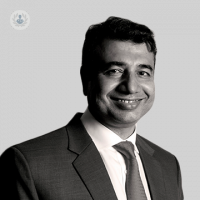What to watch for with back pain: the signs and symptoms of degenerative disc disease
Written by:Leading neurosurgeon Mr Irfan Malik explains the common symptoms of cervical disc disease, and how he and his team at the London Neurosurgery Partnership are able to correct and treat the condition.

What does the word 'disc' refer to in the spine?
The cervical spine consists of seven vertebral bodies which are interconnected by the help of a sort of cushion, which is called a disc. It consists of two components. The outer component is made up of cartilage which is strong, and the inner component is jelly which is soft.
The disc has three important functions. First, it maintains our spinal mobility. That’s why we flex, extend, and move side to side. Second, it acts as a shock absorber. And third, it acts as a weight transferring from vertebra above to vertebra below.
With time, as we grow older, it forms cracks or tears in the outer coat through which the jelly piece pop out and it can compress on the narrows and can cause pain in the arm. This is called degenerative disc disease.
Degenerative disc disease is more common in the cervical spine or in the lumbar spine because these are the most mobile parts of the spine in our body.
Symptoms of cervical disc disease
With cervical disc disease, people usually complain of neck pain, neck spasm in and in between the shoulder blade and radiating toward the shoulder and then subsequently, when there’s a compression on the nerve, people feel pain and aches in the arms. They feel numbness in the arms, sometimes paresthesia, and upon careful questioning, they start losing dexterity in the hands.
When the disease gets to the more advanced stage from patients start to drop things, and if there’s a compression on the spinal cord, people do feel that they’re losing their balance and they become more stiff and wobbly.
Symptoms of disc disease in the lumbar spine
If the problem is in the lumbar spine, people usually complain of lower back pain and then when there’s a compression on the nerve, the pains starts radiating from the lower back down to the legs. If this is not acted upon, symptoms will start to display as numbness and then subsequently weakness in the legs. If there is a significant compression on the nerve especially in the lower spine, it can affect the bladder, bowel, and sexual functions.
How can disc disease be managed?
If the patient has shown symptoms only for a short period of time, usually a non-surgical treatment which consists of physical therapy and management is offered, and the majority of patients usually get better. If, however, the problem persists or develops, or the patient develops a progressive numbness or weakness in the arms, then surgical treatment is usually offered.


